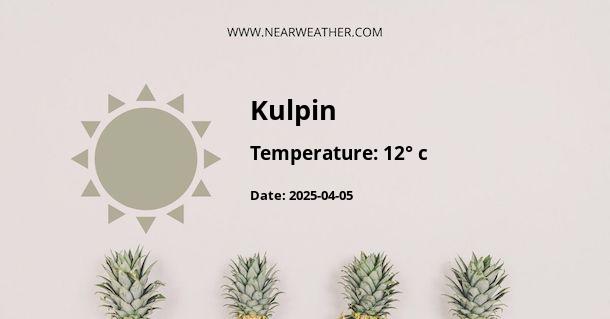Climate and Weather of Kulpin, Vojvodina, Serbia
Located in the province of Vojvodina, Serbia, the village of Kulpin is a place that experiences a climate influenced by several geographic factors. The vast Pannonian Plain and its proximity to the Danube River work together to shape the weather patterns throughout the year. Understanding the nuances of Kulpin's climate involves exploring the seasonal temperatures, precipitation, wind patterns, and extreme weather events that can occur in this region of Serbia.
Geographic and Climatic Overview
Kulpin is characterized by a continental climate, which includes warm summers and cold winters. This climatic zone is typical for areas situated in interior continents away from large bodies of water. The climate data provided in this section is derived from historical weather records and contemporary climate models.
Temperature Patterns
Kulpin experiences significant seasonal temperature variations, with cold winters and warm summers.
- Summer: From June to August, temperatures in Kulpin often reach highs of around 25°C to 30°C (77°F to 86°F). The peak of summer can even see temperatures surpassing 35°C (95°F).
- Autumn: The transition months of September to November see temperatures gradually falling. Average highs in September are around 22°C (71.6°F), dropping to 10°C (50°F) in November.
- Winter: December to February are the coldest months, with temperatures often plummeting below 0°C (32°F) and occasionally descending to -10°C (14°F) or lower during cold snaps.
- Spring: March to May witnesses a steady increase in temperature, with averages spanning from 10°C (50°F) in March to around 20°C (68°F) in May.
Precipitation and Humidity
Rainfall in Kulpin is fairly evenly distributed throughout the year with slight variations during different months.
Below is a general breakdown of average monthly precipitation:
| Month | Average Precipitation (mm) |
|---|---|
| January | 37 |
| February | 36 |
| March | 40 |
| April | 50 |
| May | 60 |
| June | 100 |
| July | 70 |
| August | 60 |
| September | 50 |
| October | 50 |
| November | 50 |
| December | 40 |
Though the region doesn't have a distinct dry or wet season, late spring and early summer are typically the wettest periods, influenced by convective precipitation patterns.
Wind Patterns
In Kulpin, the predominant winds align with the larger patterns of Vojvodina. The region experiences the Košava wind - a cold and very gusty southeastern wind. It can last for several days, primarily during autumn and winter, impacting both temperatures and perceived thermal comfort.
Extreme Weather and Climate Events
While Kulpin enjoys a relatively temperate climate, it is not immune to extreme weather. Heatwaves, particularly in the last two decades due to climate change, have become more frequent in the summer months. Conversely, extreme cold can occur during the winter, sometimes accompanied by heavy snowfall that can disrupt the normal flow of life.
Floods are another concern, especially given Kulpin’s proximity to the Danube River. Greater frequency and intensity of rainfall events can lead to rising water levels and inundation of floodplains. On the other end of the spectrum, droughts can affect agricultural activities, which are a significant part of the local economy.
Seasonal Climate Details
Spring
Spring heralds a period of transition with temperatures progressively warming. Frost and light snow are possible earlier in the season, and by late spring, the landscape begins to flourish with moderate rainfall incentivizing the growth of flora.
Summer
The warmest time of the year, often welcomed by residents and tourists alike, can lead to bustling outdoor activities. The peak can bring about heatwaves prompting the populace to seek reprieve in cooler indoor areas or shaded greenspaces. Precipitation in the form of thunderstorms is also common.
Autumn
Autumn marks a gradual cooling, with the environment showcasing a palette of colors as vegetation responds to the changing temperatures. Harvesting occurs during this season, and the first frosts appear, signaling the oncoming winter.
Winter
Winters can be challenging, with cold temperatures necessitating adequate heating. Snow cover varies year by year, but white Christmases are not uncommon in Kulpin, something that adds to the area's winter charm.
Climate Data Record and Projection
The data for Kulpin's historic climate patterns are primarily sourced from local meteorological stations and databases. Climate models project an increase in average temperatures and potentially more erratic precipitation patterns due to global climate change, which could lead to more frequent and intense weather extremes in the region.
Tourism and Best Time to Visit
For those looking to visit Kulpin, the best time depends on the desired experience. Late spring through early autumn offers the ideal weather for outdoor activities, while winter holds its own appeal with potential for snow-laden landscapes ideal for postcard photography or enjoying local winter traditions.
In conclusion, Kulpin's climate is emblematic of continental weather patterns with vivid seasons. Those living in or traveling to Kulpin can expect a temperature climate with variability throughout the year that is both challenging and rewarding.
A - Kulpin's Latitude is 45.400829 & Longitude is 19.586941.
A - Weather in Kulpin is 12° today.
A - Climate Conditions in Kulpin shows few clouds today.
A - Humidity in Kulpin is 72% today.
A - Wind speed in Kulpin is 14.18 km/h, flowing at 136° wind direction. today.
